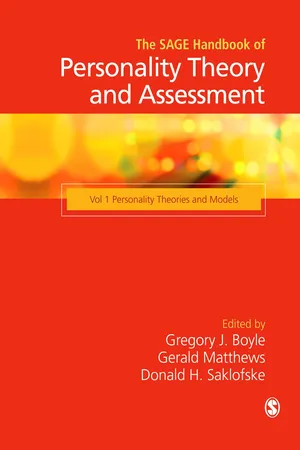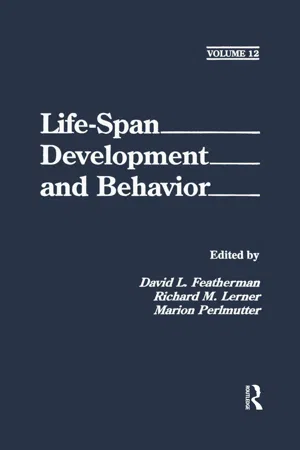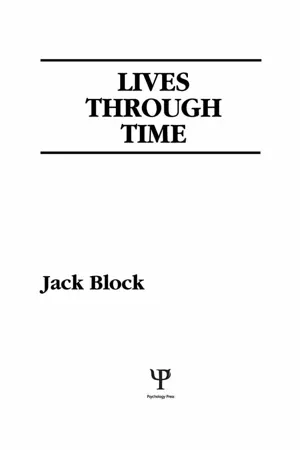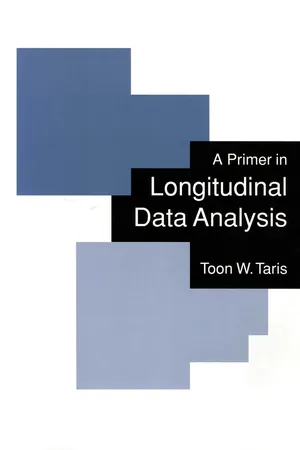Psychology
Stability vs Change
Stability vs. change in psychology refers to the ongoing debate about the extent to which individuals' traits and behaviors remain consistent over time versus how much they are subject to change. This concept is central to understanding human development and personality, as it addresses the balance between inherent characteristics and the potential for growth and adaptation.
Written by Perlego with AI-assistance
Related key terms
Related key terms
1 of 4
Related key terms
1 of 3
7 Key excerpts on "Stability vs Change"
- eBook - ePub
The SAGE Handbook of Personality Theory and Assessment
Personality Theories and Models (Volume 1)
- Gregory J Boyle, Gerald Matthews, Donald H Saklofske, Gregory J Boyle, Gerald Matthews, Donald H Saklofske(Authors)
- 2008(Publication Date)
- SAGE Publications Ltd(Publisher)
context of personality. Therefore I proceed in this chapter by discussing: (1) personality stability and change; (2) antecedents of adult personality in childhood; (3) consequences of childhood personality in adulthood; and (4) some principles of personality development. Thus, I illustrate the discussion of the developmental context of personality with questions that bridge childhood and adulthood, ignoring questions about the context of personality development during childhood and adolescence, and during adulthood. An additional discussion of the latter questions in some detail would not be possible within the space limitations of this chapter.Before proceeding further, a conceptual note about personality is in order. The definition of personality advocated here for the purpose of this chapter includes at any age any social-emotional characteristic of an individual that shows some stability over shorter time periods such as a few weeks and that varies between individuals of the same culture (personality trait). This definition includes temperament (traits related to affect, arousal, and attention) but does not restrict early personality to temperament. It does exclude traits related to cognition such as general intelligence, in line with mainstream North American research, mainly because such traits are studied in a different research tradition, and including it would be difficult within the space limitations of this chapter.STABILITY AND CHANGE OF PERSONALITY
In this section I discuss different concepts concerning the long-term stability and change of personality, and review relevant empirical findings.Individual, average, and differential change
If people think about the personality development of an individual; that is, their own child, they usually take an individual perspective that contrasts this individual across age. For example, does the child grow in body size or aggressive tendencies between ages 10 and 14? Individual change (some-times also called ipsative change) can be decomposed into two principally independent facets of change, namely average change of the agemates of the individual, and differential change of the individual, defined as the difference between individual change and average change (see Figure 5.1 - eBook - ePub
Personality Psychology
A Student-Centered Approach
- James (Jim) A. McMartin(Author)
- 2016(Publication Date)
- SAGE Publications, Inc(Publisher)
10 Continuity and Change Over the Life Course: In what ways can I expect my personality to remain the same or change over the course of my life?- Personality Stability and Change
- Absolute Stability
- Differential Stability
- Structural Stability
- Ipsative Stability
- Coherence
- Levels of Personality
- Habitual Behaviors
- Traits and Dispositions
- Personal Concerns
- Life Narratives and the Making of the Self
- Humanistic and Existential Approaches to Continuity and Change
- The Fully Functioning Person
- The Will to Meaning
- Psychodynamic Approaches to Continuity and Change
- Jung and the Process of Individuation
- Individuation and the Stages of Life
- Aging and Wisdom
Do you think it’s true, “You can’t teach an old dog new tricks”? Or do you believe the opposite proverb, “It’s never too late to learn”? If, on the one hand, “The leopard cannot change its spots,” why, on the other hand, does “Hope spring eternal in the human heart”? The ready availability of contradictory proverbs allows us to select the most convenient one to explain any outcome—after the outcome is known. All proverbs fail to specify the conditions under which some event will occur. Researchers hope to discover to what extent, and under what conditions, personality changes in adulthood.The simplest answer to the question of whether personality changes over the life course is that it depends on what we mean by “personality” and “change.” As unsatisfying as this answer is, its elaboration in this chapter serves to clarify the ways that people can and do change over the life course, the levels or aspects of personality that are involved in both continuity and change, and how personality and change are assessed or measured. We will see that a complete answer to the question involves appreciating both the continuity of certain levels of personality from youth to old age and simultaneously recognizing that other aspects of personality can be modified or reorganized. The complexity of the elaborated answer to the question of continuity and change over the life span matches the complexity of the concept of personality itself. - eBook - ePub
Life-Span Development and Behavior
Volume 12
- David L. Featherman, Richard M. Lerner(Authors)
- 2019(Publication Date)
- Routledge(Publisher)
In assessing the evidence for patterns of stability of human characteristics, I rely on a broad-based definition of the concept of personality. For present purposes I refer to virtually any conceptually defensible aspect of human functioning in which individual differences, whatever the source of these differences, can be said to exist. As noted previously, I ignore the possibility of sequences or stages of development in the sense that more complex epigenetic structures emerge from preexisting ones. Here I am concerned with differences between individuals regarding which change is possible and measurable. There is no need to restrict the domain of interest to those human characteristics studied in “personality” research, and in fact, there is every reason to broaden the search for human constancy and change to many different types of behavioral orientations, including the exercise of differential abilities, differences in self-concept and identity, differences in motivational qualities, reports of behavioral characteristics (both by self and others), and expressions of attitude and affect with respect to various social and interpersonal “objects” (see Brim & Kagan, 1980). In this review, however, I restrict primary attention to (a) available research evidence that permits control for unreliability, (b) stability estimates that are based on age-homogeneous cohort categories, and (c) stability estimates that permit the calculation of molar stability estimates. I rely on both cohort and synthetic cohort data, and although the scope of available data with these characteristics is somewhat limited, there is sufficient breadth of content in the available studies to warrant the serious consideration of these results.A. THE STABILITY OF PERSONALITY TRAITSWhen one considers the domains of personality and interpersonal behavior, the evidence of consistency is hard to establish. Mischel (1969) argued that with respect to character traits, such as rigidity, social conformity, aggression, attitudes toward authority, and on virtually any other nonintellective personality dimension, a great deal of trans-situational “behavioral specificity has been found regularly” (p. 1014). This point of view, in other words, suggests that considerable flexibility or potential for change exists in many aspects of personality. Mischel’s argument is pertinent because behavioral orientations will not be likely to endure over time if they do not endure from situation to situation. On the other hand, one might argue that the lack of consistency pointed out by Mischel and others reflects not a state of nature, but the state of measurement imprecision. Some have gone even further in stating that Mischel’s arguments are overdrawn and based on a selective review of the literature (see Block, 1977; Moss & Susman, 1980). Another, perhaps more balanced view gives greater emphasis to possibilities of human constancy. Moss and Susman, for example, argued that empirical consistency over time is “most obvious for personality characteristics that are endowed with positive cultural and societal valences” (p. 590). They indicated that such things as achievement motivation, sex-role behaviors, and interests are found to be stable from middle childhood. - eBook - ePub
Psychedelic Healing
The Promise of Entheogens for Psychotherapy and Spiritual Development
- Neal M. Goldsmith(Author)
- 2010(Publication Date)
- Healing Arts Press(Publisher)
2 IS FUNDAMENTAL PERSONALITY CHANGE POSSIBLE? THE CONCEPT OF CHANGE AND ITS ACTIONTo provide a firm foundation for our logical analysis of change, let’s start by defining the term in its most fundamental sense, in mathematics and physics—but simply—and then work our way up to more complex connotations of change in psychology and human relations.Perhaps the most basic component of any definition of the term change is that change requires the passage of time. Even in a flat line (see figure 2.1 ), when nothing seems to be changing, the passage of time itself is a change. With a slope (see figure 2.2 ), we can see change in its continuous, increasing form. In figure 2.3 , we see that with great variability, change can still be a net flat slope. With a sine curve (figure 2.4 ), we’ve simplified random variation into its simplest net-zero form, but when we increase the slope of the sine curve to 45 degrees (see figure 2.5 ), the sine curve turns into a stepwise curve. Even more interesting, due to the concavity and convexity around the inflection point of the curve, there is an energy sink on the most horizontal portion of the curve, leading to a certain inertia before great transformative change. Likewise, there is a corresponding overhang—a negative arc at the most vertical portion of the curve—that, like an overhanging ledge mountain climbers sometimes encounter, may seem impossible to get up over, but through a leap of faith or a quantum jump, we can surmount. Of course, when applying these abstract mathematical ideas to our own personal challenges, the way stepwise change works is that once you get over the hump and are on the next higher horizontal section looking back down, the developmental challenge of the prior vertical wall that we were just struggling with so mightily will now seem quite obvious.Figure 2.1. Flat LineFigure 2.2. SlopeFigure 2.3. Static; No Change in the Real WorldFigure 2.4. Sine Curve - eBook - ePub
- Margret M. Baltes, Paul B. Baltes(Authors)
- 2014(Publication Date)
- Psychology Press(Publisher)
product of processing self-referent information at any point in time during the life-span. This view allows for a distinct investigation of content, structure, and function of the self-concept, to which we now turn.Change Versus Stability In Content . “Content” may be thought of in terms of the knowledge about the self with regard to a more or less differentiated spectrum of behavioral classes or domains (e.g., ability or sociability). Accordingly, change in content usually is studied by observing age-related changes or age differences in those attributes that seem to comprise the individual’s self-knowledge.For example, Montemayor and Eisen (1977) observed an increase in self-cognitions related to psychological attributes and a decrease in “visible” ones (e.g., physical) during adolescence. Monge (1975) has reported differences between various age-groups from adolescence to old age in four components of the self-concept (e.g., adjustment, achievement). Mortimer et al. (1982) investigated competence, unconventionality, sociability, and well-being as components of the self-concept in a college population; their longitudinal data yield considerable stabilities in content over a 14-year time span. Cross-sectional comparisons based on self-descriptions on 18 personality dimensions have been reported to be highly indicative of content-related stability during the adult years (McCrae & Costa, 1982).However, two central problems seem to be widely overlooked in investigations related to the content of self-referent knowledge. The first problem lies in the mode of self-concept measurement usually employed: A standardized format (e.g., rating scales) that presumably allows individuals to describe themselves, but only according to attributes and traits preselected by the researcher. However, if “no two life histories are identical” (Scheier & Carver, 1980), how can we expect those experiences to be identical, from which self-related knowledge has been inferred and which form the base of what individuals have learned about themselves? - eBook - ePub
- J. Block(Author)
- 2014(Publication Date)
- Psychology Press(Publisher)
Chapter VIPERSONALITY CONSISTENCY AND CHANGE OVER TIME AS A MODERATOR VARIABLE OF LONGITUDINAL TRENDSIn a study which independently evaluates an individual’s character at several widely separated intervals, it is a natural and intrinsically engaging question to inquire as to the degree of personality consistency or change which has been manifested by the individuals who have been followed over time. In the everyday world, this kind of interest looms large. We reflect upon the changes time and experience have wrought upon an old friend now re-encountered. We ponder—or should—upon how it will be to live a life with someone else. Is a current infatuation a mate “for all seasons?” In career projections, we ask—Is this student worth special backing because he is likely to become a productive and creative member of his society? Irretrievable decisions are predicated upon the answers, usually formulated viscerally, to such questions. Considerations of personality consistency and personality change are important here and the present study brings some data to bear on these matters.The question of consistency and change over time, as it is usually put by the layman, is framed in an overall, somewhat naive, but nevertheless telling way, and this is the way we shall be attempting to answer it. The initial impulse of psychologists when asked “Is the character of people consistent or does personality change over time?” is to reply primly, “Consistent with respect to what? Change with respect to what?” If pressed to an empirical response, the psychologist usually will correlate subject positionings on a single variable over time and report consistency or change only in these variable-qualified terms.This approach is not wrong; indeed, its usefulness has been evidenced in the preceding chapter. But it does not speak to the overall question with an overall answer. Do people change a lot or a little over time? The question makes sense and this chapter marshalls data to answer it. Further, because some individuals stabilize their character early and others are markedly transformed over the years, an attempt has been made to trace the developmental implications of such personality consistency and personality change. - eBook - ePub
- Toon W Taris(Author)
- 2000(Publication Date)
- SAGE Publications Ltd(Publisher)
Measuring Concepts across Time: Issues of Stability and Meaning
This chapter addresses the concept of change (and its complement, stability) in longitudinal research. I first discuss four types of across-time change that may occur (structural, normative, level, and ipsative stability, respectively), showing that the latter three types of change (stability) can only be examined if the structure of a concept that has repeatedly been measured did not change across time. Then a three-step confirmatory factor-analytic procedure is presented to examine various types of across-time change in the structure and meaning of concepts. Finally, an example of this procedure is presented.What do we talk about when we talk about stability and change?
Most – if not all – longitudinal survey research focuses on change and its prediction. Across-time change is often examined in terms of mean differences on data collected at the waves of the study. For example, are married couples right in thinking that having children will improve the quality of their marriage (Glenn and McLanahan, 1982)? How does the transition toward non-virginhood affect the sexual behavior and sexual attitudes of young people (Taris and Semin, 1995)? How do the perceptions, needs, and personal reactions of newcomers in an organization change as a result of the organizational socialization practices they encounter (Feij et al., 1995)? In cases like these, the longitudinal approach has yielded valuable insights into the effects of events such as childbirth and first sexual intercourse, and organizational socialization practices, on the attitudes and behaviors of people. However, a parallel line of research has demonstrated that phenomenological processes may lead people to constitute and reconstitute their interpretation of their environment and the events that occurred to them (Berger and Luckman, 1966; Gergen, 1977; Mortimer et al., 1982).
Index pages curate the most relevant extracts from our library of academic textbooks. They’ve been created using an in-house natural language model (NLM), each adding context and meaning to key research topics.
Explore more topic indexes
Explore more topic indexes
1 of 6
Explore more topic indexes
1 of 4






